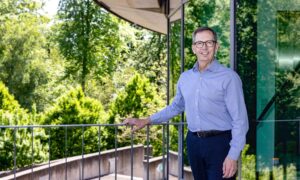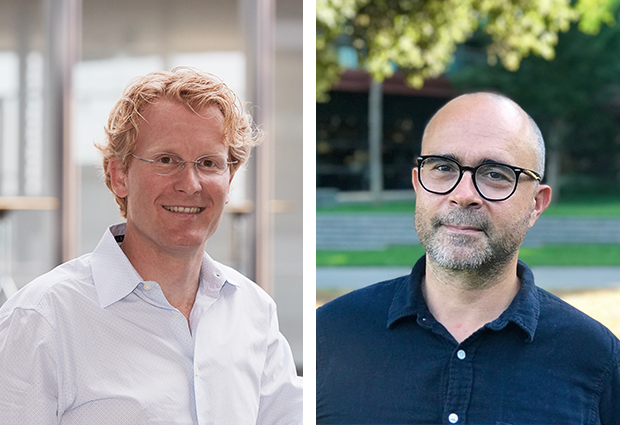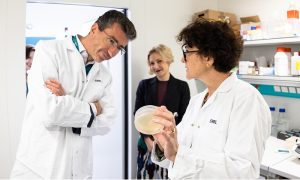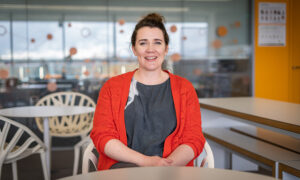
EMBL in the USA: future facing
Leading scientists will discuss the challenges ahead for international science

The upcoming EMBL in the USA event promises a lively discussion of big questions and challenges to be addressed in life science research across institutions and continents. EMBL Director General Edith Heard and a number of EMBL senior scientists will be among the speakers at the two-day symposium, which will take place at Stanford University from 8–9 November. EMBL alumnus and EMBL | Stanford Life Science Alliance member Georgios Skiniotis, and Director of the Life Science Alliance and EMBL senior scientist Lars Steinmetz look ahead to the event.
Georgios Skiniotis, Professor of Molecular and Cellular Physiology, and Structural Biology, Stanford University
Tell me about your current position, and what you’re working on.
At Stanford, I have a joint appointment between two departments – Molecular and Cellular Physiology, and Structural Biology. For the last few years, my main focus has been on the structural biology of membrane proteins: in particular, a class of proteins called G protein-coupled receptors. This is the largest family of receptors in humans, and they control all aspects of communication between cells and their environment. All these receptors recognise very different molecular signals from outside the cell – light, odour, secreted chemicals, and so on – but intracellularly they all use the same type of signalling mechanism. Understanding these transmembrane signalling events is one of the key aspects of our work. Another aspect has to do with drug discovery. This is because G protein-coupled receptors are very promising targets for new therapeutic approaches. Around 40% of drugs in current use target these receptors. To design new drugs with improved properties to go after these targets, we need structural information about the receptors. We have now started getting this information by using cryo-electron microscopy.
What’s your connection with EMBL?
I was a PhD student at EMBL from 1999 to 2002, in Andy Hoenger’s group. I stayed on in the lab as a bridging postdoc for another nine months and worked on a couple more papers before moving on to do a postdoc in Boston.
Why do EMBL alumni feel such a strong connection to EMBL?
EMBL is a very special place. I can say that, having experienced different types of universities and institutions. It pulls together a very diverse mix of scientists. At EMBL, you interact closely with people from other programmes. No matter whether you’re in developmental biology, structural biology or some other discipline, there’s always a connection – there’s always crosstalk. Also, EMBL is truly international. We take it for granted, but we shouldn’t; other universities or institutions may have an international mix of people, but they don’t necessarily have an international character. I was looking for a space where I could do good science, but I also wanted to grow as a person through interactions with other people, and EMBL provided the right environment for this. It’s a unique place – up on the mountain, somewhat isolated, but also open – where scientists can comfortably, constantly collide.
What are the benefits of this type of event?
Science is evolving and becoming increasingly complex, and in order to make headway you need to build strong and healthy collaborations. When people with a shared background come together in a different setting, new connections are formed and opportunities for working together in new ways can emerge. The other special thing about these events is getting to hear about different types of science from people who are highly respected in their fields. I’m always open to the possibility of coming across something totally unexpected that might push me in a different direction.
What advice would you give to a young scientist starting out in their research career?
There’s no point in doing something that closely resembles what’s been done before. If there’s a very clear roadmap of how you’re going to achieve your PhD, with all the steps already delineated, I don’t think it’s worth doing. You need to take risks to do something important. Put your goal far away, dream big, and don’t be intimidated by the challenge.
Lars Steinmetz, EMBL senior scientist and Director of the EMBL | Stanford Life Science Alliance
What is the EMBL | Stanford Life Science Alliance, and how did it come about?
I’ve had a joint lab between EMBL and Stanford University since 2003, and my research has benefited tremendously from the opportunities that exist at each institution. In our projects, we can use cutting-edge technologies developed on either side, and we have a large set of local collaborators to network with. It means we can work on projects that would not otherwise be feasible. It’s been a dream opportunity to work on science on both sides of the Atlantic and to take advantage of the unique cultural ways in which people approach science, as well as the infrastructure that’s available at these institutions. The idea behind the Life Science Alliance is to take these advantages and spread them throughout the communities at EMBL and Stanford.
Thanks to a generous donation from the Dieter Schwarz Foundation in Germany, we’ve launched three initiatives to do so. The first of these is a joint postdoc programme to further high-risk, high-gain projects. Postdocs will receive a three-year fellowship to work on a collaborative project between the two institutions. They will hold a primary appointment at either EMBL or Stanford, and will have an opportunity to spend up to one year as a visiting researcher at the other. Our second initiative is an exchange grant programme for faculty, staff and postdocs, to facilitate inter-institutional visits of up to three months. And the third is the sponsoring of joint events and a visiting excellence lecture series. The EMBL in the USA event is happening at a good time for us, as it coincides nicely with the launch of these initiatives. It’s an opportunity to connect with the EMBL alumni community here in the Bay Area and across the US, and to stimulate further exchange and collaboration.
What are your aspirations for the upcoming symposium?
It’s going to be a stimulating meeting, hopefully with active participation and discussion, and engagement with new ideas on international science. One of our big themes is the future of international science, and how we can tackle biological problems on a global scale. Many of the themes we work on in science affect every individual on the planet, and we have unique resources in different countries – so how can we harness these and bring them together? It would be fantastic if some of the discussions stimulated new projects and inter-institutional collaborations, and the establishment of longer-term relationships.
Does holding the event in Stanford afford any unique opportunities?
Stanford is at the heart of innovation, in Silicon Valley, and a lot of our EMBL alumni in the US are entrepreneurs. So I think this is an opportunity to think about projects and collaborations at a level where industry can get involved – to take innovations from the lab to the market. This is ultimately one of the major ways that we can bring the benefits of science to society.


